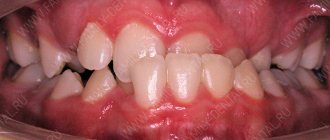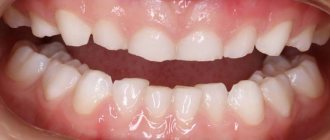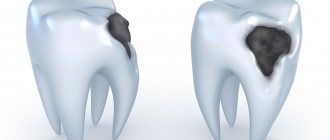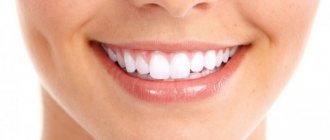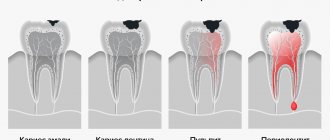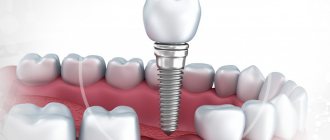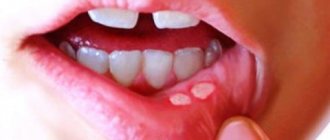Content
hide
1 Pulp - structure, functions, features
2 Why is a tooth without pulp considered dead?
3 How long does a tooth live without pulp?
4 What can lead to the need to remove a “dead” tooth: 4.1 There are several rules by adhering to which patients can prolong the use of the tooth:
Inflammation of the “nerve” of the tooth (pulpitis) is not always accompanied by severe toothache. A chronic infectious process can occur in a tooth unnoticed, leading to significant tooth destruction, the formation of a cyst on the root of the tooth, and even tooth loss. This pathology is an indication for tooth depulpation—removal of its “nerve.” Sometimes such news can come as a surprise to a patient if he did not suspect the presence of chronic pulpitis. At the same time, we are often asked - what will happen to the tooth later, after pulp removal? How long will the tooth live after this procedure, how will its condition change? We'll talk about this in the article.
What to do with a dead baby tooth?
If you notice a change in the color of one of your child's baby teeth, the tooth may be dying. There is usually no need for treatment as they will fall out anyway. However, you should monitor the tooth for signs of infection and take your child to the pediatric dentist for a checkup . The dentist may take x-rays to determine if there are underlying problems that are causing concern.
Causes of depulpation
There are a number of indications for dental nerve removal. Depulpation is most often carried out in the following cases:
- with extensive carious lesions affecting the dental nerve;
- development of infection in the dental canal;
- mechanical damage to the pulp;
- In the process of preparing for prosthetics, even a healthy pulp may be removed; this is necessary to eliminate the risk of developing re-inflammation in the tooth after the installation of an orthopedic structure.
The procedure for removing pulp from a tooth is performed in the following sequence: 1. Based on an x-ray taken, the doctor determines the structure and size of the dental canals. 2. Local anesthesia is administered. 3. The pulp is removed first in the coronal and then in the root part of the tooth. 4. Dental canals without pulp are carefully treated with an antiseptic solution. 6. After treatment, the canals are sealed. 7. Most often, a temporary filling is subsequently placed on the tooth, which later must be replaced with a permanent one.
Treatment of a dead tooth
Your dentist has a choice and knows how to treat a dead tooth. He may take x-rays to determine the best course of action, but you can expect one of two results.
- Extraction or removal of a tooth with the installation of a bridge or implant in its place.
- Root canals can save a tooth. However, multiple procedures may be required to save a tooth, and a crown may be needed to support a weakened tooth.
How to save a dying tooth naturally
Dentists prefer to preserve natural teeth whenever possible because nothing looks or feels quite like them. Tooth extraction can affect your ability to speak and eat, and can also affect your smile, especially if you have a dead front tooth. This is why root canals remain the preferred treatment for a dying or dead tooth, and you should advocate for this option.
Avoiding tooth extraction is extremely important and is a huge reason to visit your dentist regularly for checkups . They may notice signs of a dying tooth early during an examination or on x-rays. The sooner you notice this, the better the result will be.
Possible complications and consequences
If you do not consult a specialist in time for severe pain in a pulpless tooth, the following serious complications may occur: 1. Purulent inflammation in the tooth (granuloma). 2. Formation of a cyst in the tooth. 3. Loss of the affected tooth. It should be remembered that pain in a pulpless tooth can be normal only in the first few days after treatment. Under other circumstances, the presence of pain in the tooth most likely indicates the development of a pathological process that must be eliminated as soon as possible. In most cases, the appearance of pain when pressing on a tooth or chewing food indicates poor quality treatment. If toothache does not go away a few days after dental procedures, then there is no need to hesitate to visit the dentist. Only a doctor can determine the condition of the tooth, identify the cause of concern and prescribe the necessary treatment. Complications that may develop due to the lack of necessary treatment are much more difficult, longer and more expensive to treat. In addition, lack of treatment can lead to diseases of neighboring healthy teeth. In order not to detect diseases at the complication stage, you need to regularly, every six months, visit the dental clinic for a preventive examination by a specialist. At the Innovative Dental Clinic on Marata-31, dentists conduct free medical examinations for their patients. The clinic employs competent specialists with extensive experience. Treatment in the clinic is carried out using modern equipment, in compliance with all regulatory standards of dental treatment. You can make an appointment with specialists on our website using the online appointment form or by phone. We work seven days a week and will always be happy to find a convenient appointment time for you. Sign up, with us your teeth will be healthy!
Methods for restoring the aesthetics of a pulpless unit
Darkening of tooth enamel is an aesthetic problem that not all patients can accept. Dentists offer a number of methods aimed at restoring the external characteristics of a “dead tooth.” What to do in this case? There are 3 main methods for restoring blackened enamel: endobleaching, installation of veneers and crowns. Let's consider each of the listed methods in more detail.
Endobleaching
The method involves introducing whitening agents into the upper layers of the tooth. Typically, dentists use sodium perborate for the procedure. Endo-whitening is possible not only to restore the aesthetics of a “dead” tooth, but also to lighten the enamel tone in healthy teeth.
A healthy element loses its original external characteristics due to a number of factors:
- pulp damage followed by hemorrhage;
- installation of a composite, which began to color the crown of the tooth in a pinkish tint;
- darkening of the crown as a result of silvering of the tooth.
Endobleaching is performed according to the appropriate algorithm:
- Performing professional cleaning to remove hard and soft dental plaque.
- Removing old fillings.
- Injection of a bleaching agent into the cavity of the problematic element.
- Installation of a temporary filling.
The procedure is performed every week until the tooth becomes similar in shade to the rest of the row. The minimum number of visits to the dentist is 4–5 times. The permanent composite material is installed 10 days after the last gel injection procedure.
The results of endobleaching last for an average of 2–3 years. After this time, the procedure is repeated again in cycles. Patients are not recommended to undergo more than 3 courses of whitening due to the risk of crown breakage.
This method has a number of disadvantages:
- Impossibility of predicting the result of restoration.
- The impossibility of completely restoring the enamel due to its dullness.
- There are a number of contraindications to the procedure: allergic reactions to the injected bleaching agents; pregnancy; cracks in the enamel; pathologies of the endocrine system.
Veneers
The structures are thin linings made from several types of materials - ceramics and composites. Ceramic plates are often made from zirconium dioxide or porcelain. Porcelain veneers are identical to the enamel color of healthy units. This is achieved due to the transparency of the composites used.
Composite veneers are more affordable, but their service life does not exceed 5 years. This is due to the fragility of the products and their rapid loss of their original appearance.
Installation of veneers is also carried out in stages:
- Selection of the optimal shade of the plates.
- Grinding of the top layer of enamel for better attachment of the product to the tooth. During the procedure, about 0.5–1.5 mm of enamel is ground off.
- Manufacturing of crowns on special machines using 3D technologies. Products are produced in dental laboratories using impressions previously taken from the patient’s dentition.
- Fixation of finished structures using a special adhesive.
There are contraindications for installing veneers:
- bite pathologies;
- enamel abrasion;
- high risks of dental injury;
- bruxism;
- element wobble.
The most significant disadvantage of veneers is the need to wear them throughout your life. This is due to the fact that the teeth on which the onlays are installed are subjected to preliminary grinding and can no longer be restored.
Crowns
Dentists consider this method of restoring the appearance of a “dead” tooth to be preferable. This is due to several reasons:
- Increasing the strength of a problem unit by 30–60%.
- Possibility of preserving the root during the procedure.
- Possibility of ensuring uniform load on all areas of the jaw.
- Protection of tooth tissues from external negative influences.
- The disadvantage of the procedure is the need to grind the top layer of the tooth.
All methods of restoring a “dead” tooth have a negative impact on its health. In order not to resort to the restoration procedure, it is necessary to follow a number of preventive rules. These include: timely visits to the dentist; competent choice of dental care products; daily hygiene measures; flossing after meals; high-quality cleaning of the surface of the tongue; timely change of toothbrush (once every 3 months).
Clinical researches
Clinical experiments with the use of the Asepta series of products, conducted at the Ryazan State Medical University named after Academician I.P. Pavlova of the Ministry of Health and Social Development of the Russian Federation (GBOU VPO RyazSMU Ministry of Health and Social Development of Russia) have proven that the use of Asepta line products results in a decrease in complaints of discomfort, but bleeding persists when brushing teeth.
On examination, hyperemia and bleeding of the gingival papillae are noted. On the 7th day, complaints of gum bleeding persisted in 4 patients. Upon examination, a decrease in hyperemia and swelling of the gums was noted, but bleeding persisted upon probing. On day 14, 2 patients continued to complain of bleeding gums when brushing their teeth; upon examination, a significant decrease in hyperemia and swelling of the gums was noted. After the final application of the gel with propolis, normalization of clinical manifestations was revealed, which is manifested by the absence of bleeding during brushing and probing.
Sources:
- Clinical experience in using the Asepta series of products Fuchs Elena Ivanovna Assistant of the Department of Therapeutic and Pediatric Dentistry State Budgetary Educational Institution of Higher Professional Education Ryazan State Medical University named after Academician I.P. Pavlova of the Ministry of Health and Social Development of the Russian Federation (GBOU VPO RyazSMU Ministry of Health and Social Development of Russia)
- Report on determining/confirming the preventive properties of toothpaste “ASEPTA PLUS” GENTLE WHITENING” Author: doctor-researcher A.A. Leontyev, head Department of Preventive Dentistry, Doctor of Medical Sciences, Professor S.B. Ulitovsky First St. Petersburg State Medical University named after. acad. I.P. Pavlova, Department of Preventive Dentistry
- Clinical and laboratory assessment of the influence of domestic therapeutic and prophylactic toothpaste based on plant extracts on the condition of the oral cavity in patients with simple marginal gingivitis. Doctor of Medical Sciences, Professor Elovikova T.M.1, Candidate of Chemical Sciences, Associate Professor Ermishina E.Yu. 2, Doctor of Technical Sciences Associate Professor Belokonova N.A. 2 Department of Therapeutic Dentistry USMU1, Department of General Chemistry USMU2
- Report on the determination/confirmation of the preventive properties of personal oral hygiene products “ASEPTA PLUS” Remineralization doctor-researcher A.A. Leontyev, head Department of Preventive Dentistry, Doctor of Medical Sciences, Professor S.B. Ulitovsky First St. Petersburg State Medical University named after. acad. I.P. Pavlova, Department of Preventive Dentistry

